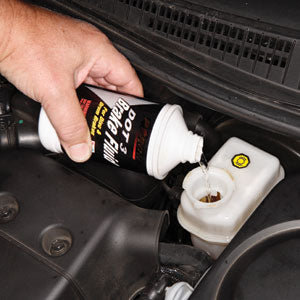
How to bleed your brakes - Manual method
Let It Bleed
To properly bleed the brakes, start with a quality fresh brake fluid. An unopened can has a long shelf life. An opened can should be discarded within a few weeks. Get the vehicle up in the air and remove the wheels.
If you can't turn the bleeders without breaking them off, you can try a 6 point socket over them, just don't break them off! See the above notation about penetrating oil and light hammer taps before applying enough torque to break these minuscule, hollow bolts.
Ideally you should remove as much of the old fluid from the brake reservoir as it absorbs moisture. We do offer a brake fluid moisture testing tool here: https://alconkits.com/collections/tools/products/brake-fluid-tester. Sneak into the kitchen and appropriate the small turkey baster. Remove the top to the master cylinder reservoir and suck out as much of the old fluid as you can. Does it look dark? that means it was definite time to replace. Clean any sediment out of the reservoir by sucking it up. Do not spill any brake fluid on any painted surfaces -- it will remove the paint pretty much immediately.
Get a piece of clear plastic tubing (aquarium tubing is fine, and it's cheap). Push one end of the tube over the brake bleeder bolt at the right rear of the car. Put the other end of the tube into a small, clear bottle with an inch or two of clean brake fluid in it. (This will keep air from being sucked back into the brake cylinder or caliper.) Put a piece of 1 x 4 lumber or some other spacer under the pedal to prevent the pedal from traveling too far when line pressure is released. Top off the master cylinder reservoir with fresh fluid and put the cover back on the reservoir. Fluid may squirt out of an open reservoir every time the pedal is released.
You can also use one of our handy brake bleeding bottles here: https://alconkits.com/collections/tools/products/brake-bleeder-bottle they use a magnet or cable hanger to make this easy. We like the magnet mount to stick it right to the brake disc.

Cue the Helper
Your helper needs to be someone who can follow instructions exactly. He or she won't get dirty hands so you don't need to pull one of your pals away from the ballgame. A teenager in a white dress will do fine. Have your helper sit in the driver's seat and await your orders. Here's the drill: You say "down." He or she depresses the brake pedal with about the same amount of force needed to keep the car from rolling forward at a traffic light. Then your helper says "down" and keeps the pressure on. When you hear the call, warn your helper that the brake pedal is about to sink underfoot and to keep the pressure on constantly. Then crack the bleeder bolt a quarter-turn.
A bleeder bolt can become difficult to remove. Use a proper-fitting box wrench to keep from rounding it off.
Some of the old, contaminated fluid will trickle down the tubing into your bottle. When the trickle stops, close the bleeder. Then you say "up." Your helper says "up," and removes his or her foot from the pedal.
Repeat this process until fresh, clear fluid comes from the bleeder. Any out-of-sequence moves can suck air into the caliper. Yes, the end of the tubing is submerged in fluid, but air can travel past the threads on the bleeder bolt into the caliper if there's ever any negative pressure in the system while the bleeder is cracked.
Every half-dozen or so iterations, top off the reservoir with fresh fluid. Do not allow the reservoir to get more than half empty -- air can be sucked into the master cylinder unless the fluid level remains well above the bottom of the reservoir that feeds the cylinder.
Once clean fluid is coming out of the brake, snug the bleeder bolt and move your operation to the next wheel and start all over again. Don't forget to keep the reservoir topped off. For the most thorough bleeding, start with the wheel farthest away from the reservoir and work your way to the closest.


